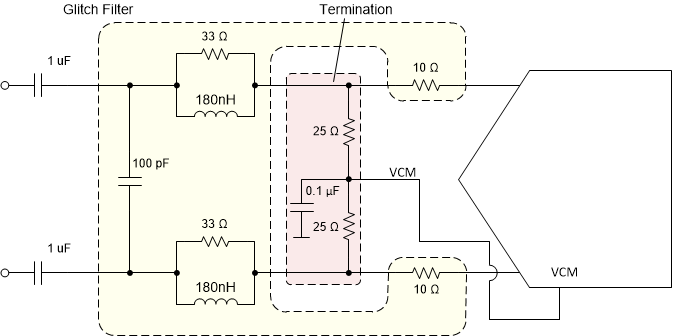ZHCSNB7A February 2021 – October 2022 ADC3581 , ADC3582 , ADC3583
PRODUCTION DATA
- 1 特性
- 2 应用
- 3 说明
- 4 Revision History
- 5 Pin Configuration and Functions
-
6 Specifications
- 6.1 Absolute Maximum Ratings
- 6.2 ESD Ratings
- 6.3 Recommended Operating Conditions
- 6.4 Thermal Information
- 6.5 Electrical Characteristics - Power Consumption
- 6.6 Electrical Characteristics - DC Specifications
- 6.7 Electrical Characteristics - AC Specifications
- 6.8 Timing Requirements
- 6.9 Typical Characteristics - ADC3581
- 6.10 Typical Characteristics - ADC3582
- 6.11 Typical Characteristics - ADC3583
- 7 Parameter Measurement Information
- 8 Detailed Description
- 9 Application Information Disclaimer
- 10Device and Documentation Support
- 11Mechanical, Packaging, and Orderable Information
8.3.1.2.2.1 AC-Coupling
The ADC358x requires external DC bias using the common mode output voltage (VCM) of the ADC together with the termination network as shown in Figure 8-6. The termination is located within the glitch filter network. When using a balun on the input, the termination impedance has to be adjusted to account for the turns ratio of the transformer. When using an amplifier, the termination impedance can be adjusted to optimize the amplifier performance.
 Figure 8-6 AC-Coupling: termination network provides DC bias (glitch filter example for DC - 30 MHz)
Figure 8-6 AC-Coupling: termination network provides DC bias (glitch filter example for DC - 30 MHz)